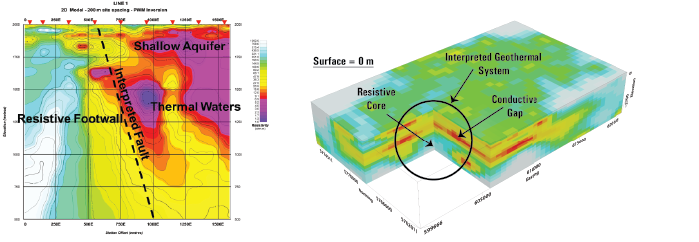Geothermal Exploration Services

Quantec helps geothermal companies prioritise drilling operations, making it easier to determine the viability of a potential geothermal resource.

Robust deep surveys and advanced interpretations for geothermal projects
SPARTAN MT for deep accurate resistivity mapping
Geophysics plays an important role in geothermal exploration. Electrical data provide a substantial contribution to the process of geophysical mapping and monitoring of geothermal reservoirs by measuring various physical parameters of the subsurface rocks, such as resistivity, susceptibility and density. Geophysical methods provide essential data for identifying and developing these valuable resources in an environmentally friendly, reliable and cost-effective way. Geothermal exploration programs are typically designed to locate and characterize geothermal resources, with the ultimate goal of building a model of the reservoir using geologic and geophysical exploration techniques.
A geothermal system or a hydrothermal reservoir is defined and controlled by a combination of factors;
Solid matrix – geological formation and alteration
- Pore fluids – chemistry and salinity
- Porosity – geological fissure and fracture
- Temperature
Resistivity is a useful tool that can relate to any and all of these key factors. MT data are used to calculate the electrical resistivity distribution of the subsurfaceto great depths.
How MT is used in Geothermal Exploration
Magnetotellurics is a non-invasive and environmentally conscious method for imaging the subsurface. Flexible and robust, it easily navigates obstacles other technologies face and can mobilise in any climate or location. The MT method is effective at mapping resistivity anomalies associated with geothermal structures including cap rock, faults and reservoir morphology. Generally speaking, rocks containing fluids such as water will have a low resistivity while dry rocks will have high resistivities. Alteration such as clay can also be mapped with resistivity.
The Magnetotelluric (MT) Method
SPARTAN MT is a passive electromagnetic system that maps resistivity by measuring telluric currents induced in the earth by naturally occurring sources such as; lightning, solar flares and ionospheric resonances. MT images the earth’s subsurface by measuring natural variations of electrical and magnetic fields at the Earth’s surface. Depth of investigation ranges from surface to 10,000m and beyond by recording higher frequencies with long-period sounding. Data are measured and converted to resistivity and then modeled to interpret the geology of the survey area in 3D. Low frequency signals are generated from the interaction of solar wind with the earth’s magnetic field, while high frequency signals are created by worldwide thunderstorm activity (typically located near the equator.) The signals vary in strength over time (ie. hours, days, weeks) and create time-varying electromagnetic waves. Longer MT measurements are required at each station in order to obtain high-quality data when exploring to greater depths.
Read more about Magnetotellurics found on our REFERENCE page.
Quantec offers worldwide coverage and availability for SPARTAN MT surveying. We have completed numerous remote MT surveys tailored for the needs of our Geothermal clients in Turkey, USA, Canada, Australia, Chile, Mexico and Africa (to name a few.)
A SPARTAN MT crew in Ethiopia
